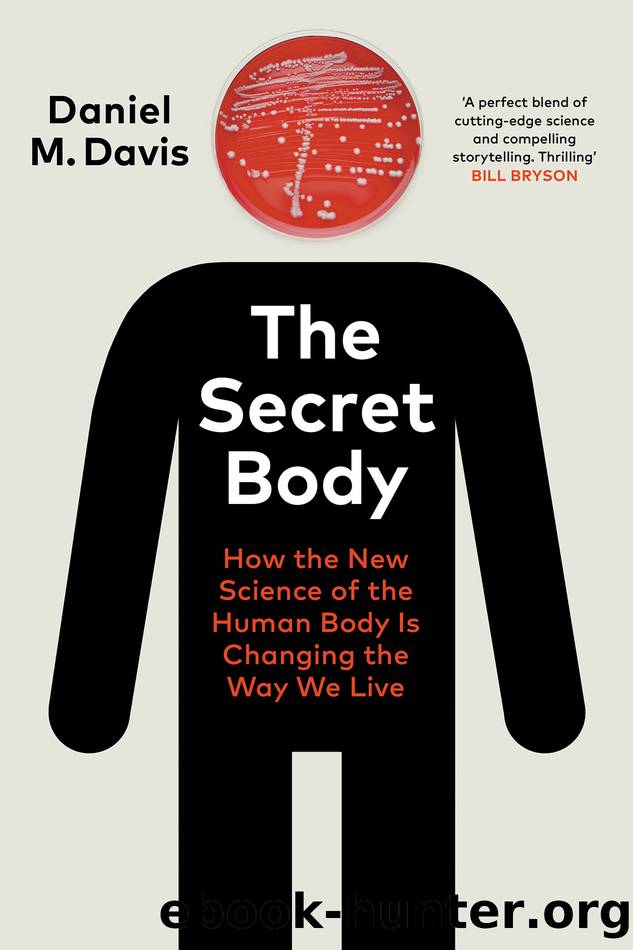The Secret Body by Daniel M Davis

Author:Daniel M Davis [M. Davis, Daniel]
Language: eng
Format: epub
ISBN: 9781473566347
Publisher: Random House
5 The Others Within
My teeth are kept usually very clean, yet when I view them in a magnifying glass, I find growing between them a little white matter ⦠[and] to my great surprise perceived that the aforementioned matter contained very many small living animals.
Anthony Leeuwenhoek, letter to the Royal Society, 17 September 1683
In the 1970s, it was thought that about 300 different species of bacteria might be found in the human body. With this in mind, scientists at the time set out to identify a core set of bacteria found in healthy people, thinking that if any of these were missing, it would indicate disease, or perhaps even be an underlying cause of disease. Now we know that this idea was far too simplistic. In fact, the human body hosts an ecosystem of micro-organisms of unimaginable diversity. There are about as many individual bacteria in you as there are human cells. They comprise around 10,000 different species of bacteria, some of which are not known to exist anywhere else on Earth. Altogether, these bacteria carry about 1,000 times as many genes as your own human genome. As well as this, there are untold numbers of viruses and fungi in, and on, our bodies, about which we know far less than we do the bacteria. In total, this â the human microbiome â amounts to something akin to an organ weighing about the same as a human brain. The reason itâs not easy to relate the contents of a personâs microbiome to disease is that this vast universe of life within our bodies is enormously diverse and â unlike any other human organ â it varies considerably from person to person, and changes during the course of our lives, as we go through puberty, pregnancy or even when we move house.
In the last decade or so, our understanding of the microbiome has exploded, thanks to the development of two types of technology which together identify microbes genetically. First, laboratory hardware can be used to rapidly sequence large amounts of genetic material.1 Secondly, we have developed computer hardware and software that allow us to sort out all the different microbial gene sequences, seek patterns in the data and correlate results with other factors, such as a personâs diet or state of health. The endeavour to understand the human microbiome has become a flagship enterprise for big-data science.
Even though the full extent of the symbiosis of humans and microbes is yet to be realised, there is no doubt that our health and wellness vitally depend on their alliance. And like any long-term relationship, the bond is complicated. Different parts of the body are colonised with different microbes, for example. Those that live on our teeth are different from those on our skin or in our gut. Even in a personâs gut, there is exquisite diversity in the types of bacteria that live along its length. Separate environments, like islands hosting different animals, are created by folds in the intestinal wall and local variations in acidity, mucus and oxygen.
Download
This site does not store any files on its server. We only index and link to content provided by other sites. Please contact the content providers to delete copyright contents if any and email us, we'll remove relevant links or contents immediately.
How to Be a Bawse: A Guide to Conquering Life by Lilly Singh(6693)
Deep Work by Cal Newport(5471)
The Longevity Diet by Valter Longo(4445)
The Fat Loss Plan by Joe Wicks(4239)
The Four-Pack Revolution by Chael Sonnen & Ryan Parsons(3485)
The Ultimate Bodybuilding Cookbook by Kendall Lou Schmidt(3320)
The French Women Don't Get Fat Cookbook by Mireille Guiliano(2984)
Super Food Family Classics by Jamie Oliver(2912)
Turn Up Your Fat Burn! by Alyssa Shaffer(2812)
Factfulness_Ten Reasons We're Wrong About the World_and Why Things Are Better Than You Think by Hans Rosling(2754)
Not a Diet Book by James Smith(2726)
Tom Kerridge's Dopamine Diet: My low-carb, stay-happy way to lose weight by Kerridge Tom(2677)
Body Love by Kelly LeVeque(2630)
Self-Esteem by Matthew McKay & Patrick Fanning(2604)
The Unbecoming of Mara Dyer by Michelle Hodkin(2483)
Tone Your Tummy Type by Denise Austin(2368)
The Fat Chance Cookbook by Robert H. Lustig(2321)
LL Cool J's Platinum 360 Diet and Lifestyle by LL Cool J(2313)
Men's Health Best by Men's Health Magazine(2093)
